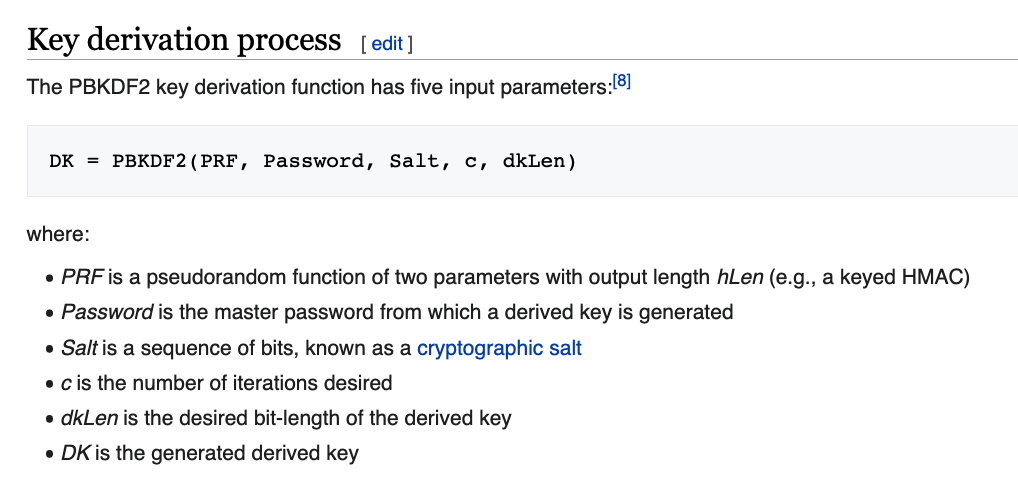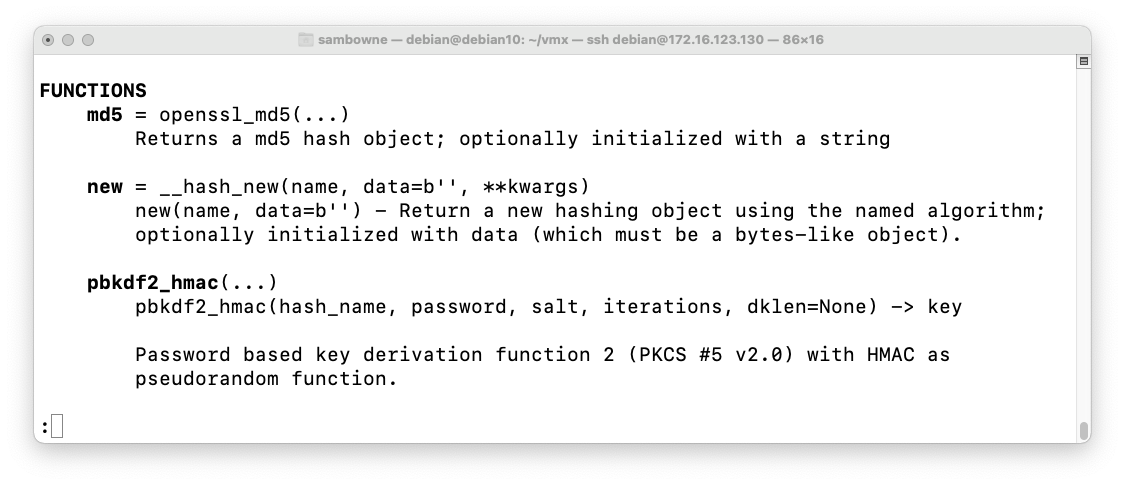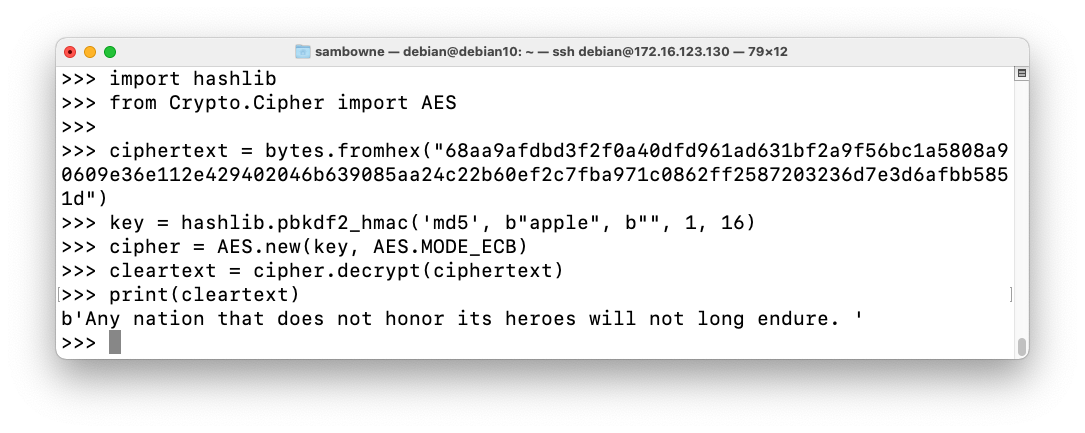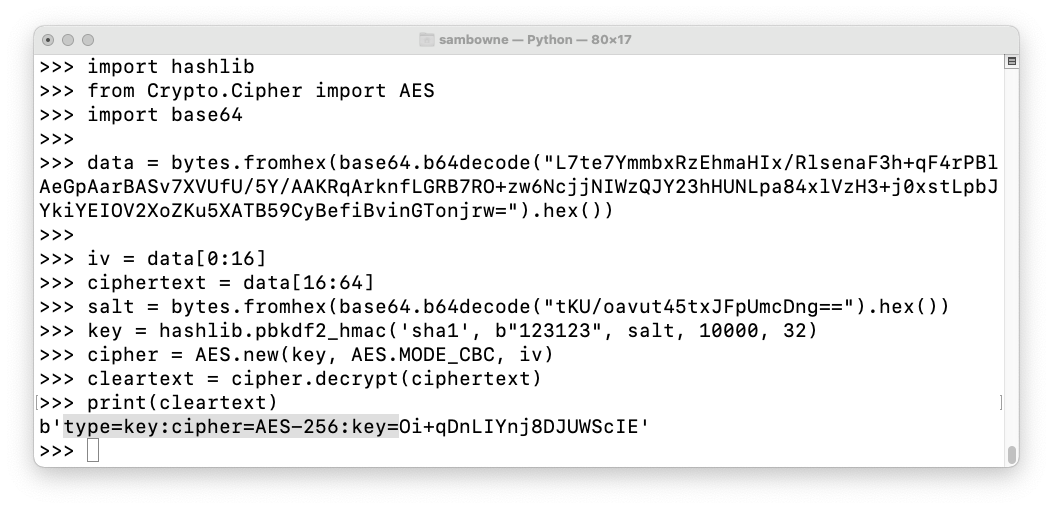
sudo apt update
sudo apt install python3-pip -y
python3 -m pip install pycryptodome
python3

import hashlib
help(hashlib)
Press q to close the help page.

Execute this command to derive a 16-byte key from the password "apple" with one round of HMAC-MD5 and no salt:
hashlib.pbkdf2_hmac('md5', b"apple", b"", 1, 16).hex()

C 203.1: Hexadecimal Values (5 pts)
Compute a 4-byte hash of this password:With these parameters:today7The flag is the hash value in hexadecimal.
- Hash name: sha1
- Salt: aaaabbbb
- Iterations: 1000
C 203.2: Crack a PIN (10 pts)
The password is a three-digit number, between 000 and 999.The hash value, using the same parameters as the previous flag, is:
Find the password. That's the flag.f68923f5Hint: for loops in Python, see project VP 100.
Execute this code to find a 128-bit key from the password "apple" and use that key to encrypt a sentence with AES:
import hashlib
from Crypto.Cipher import AES
cleartext = b'Any nation that does not honor its heroes will not long endure. '
key = hashlib.pbkdf2_hmac('md5', b"apple", b"", 1, 16)
cipher = AES.new(key, AES.MODE_ECB)
ciphertext = cipher.encrypt(cleartext)
print(ciphertext.hex())

To decrypt the ciphertext, enter this code:
import hashlib
from Crypto.Cipher import AES
ciphertext = bytes.fromhex("68aa9afdbd3f2f0a40dfd961ad631bf2a9f56bc1a5808a90609e36e112e429402046b639085aa24c22b60ef2c7fba971c0862ff2587203236d7e3d6afbb5851d")
key = hashlib.pbkdf2_hmac('md5', b"apple", b"", 1, 16)
cipher = AES.new(key, AES.MODE_ECB)
cleartext = cipher.decrypt(ciphertext)
print(cleartext)

C 203.3: Encrypt a Sentence (5 pts)
Calculate ciphertext from these parameters:The flag is the ciphertext in hexadecimal.
- Password: WSYIWYG
- Hash name: sha256
- Salt: 3xrtras4lt
- Iterations: 50
- Plaintext: Abandon all hope
- Encryption algorithm: AES-ECB
- Key size: 128 bits
C 203.4: Decrypt (20 pts)
The password contains three lowercase letters, between aaa and zzz.Using the same parameters as the previous challenge, decrypt this ciphertext:
The decrypted text contains only valid ASCII bytes, so no value is larger than 127.
This is a "keysafe": a data structure which contains an encrypted key, which can only be extracted by entering the correct password.

Making these substitutions:
encryption.keySafe = "vmware:key/list/(pair/(phrase/+IOeb4UyCwg=/There are three base64-encoded values there. The first one is an unimportant ID number, the second one is the salt, and the third one is encrypted data. The first 16 bytes of the encrypted data is the iv, required for AES-CBC.
pass2key=PBKDF2-HMAC-SHA-1:
cipher=AES-256:
rounds=10000:
salt=tKU/oavut45txJFpUmcDng==,
HMAC-SHA-1,
L7te7YmmbxRzEhmaHIx/RlsenaF3h+qF4rPBlAeGpAarBASv7XVUfU/5Y/AAKRqArknfLGRB7RO+zw6NcjjNIWzQJY23hHUNLpa84xlVzH3+j0xstLpbJYkiYEIOV2XoZKu5XATB59CyBefiBvinGTonjrw=
))"
import hashlib
from Crypto.Cipher import AES
import base64
data = bytes.fromhex(base64.b64decode("L7te7YmmbxRzEhmaHIx/RlsenaF3h+qF4rPBlAeGpAarBASv7XVUfU/5Y/AAKRqArknfLGRB7RO+zw6NcjjNIWzQJY23hHUNLpa84xlVzH3+j0xstLpbJYkiYEIOV2XoZKu5XATB59CyBefiBvinGTonjrw=").hex())
iv = data[0:16]
ciphertext = data[16:64]
salt = bytes.fromhex(base64.b64decode("tKU/oavut45txJFpUmcDng==").hex())
key = hashlib.pbkdf2_hmac('sha1', b"123123", salt, 10000, 32)
cipher = AES.new(key, AES.MODE_CBC, iv)
cleartext = cipher.decrypt(ciphertext)
print(cleartext)

C 203.5: Crack the Safe (20 pts)
The password for the keysafe shown below contains six digits. Each digit is repeated twice, like this: 112233, so there are 1000 possible keys from 000000 through 999999.Find the key to crack the safe. That six-digit key is the flag.
encryption.keySafe = "vmware:key/list/(pair/(phrase/76IjGGQzjAA=/The decrypted text contains only valid ASCII bytes, so no value is larger than 127.
pass2key=PBKDF2-HMAC-SHA-1:
cipher=AES-256:
rounds=10000:
salt=DkjJMNgtJIY/3StMtBQ0LA==,
HMAC-SHA-1,
0n1UgXgEpQ8Xun9PbStxYjmV54rkENd0+Ew4xXbhqN9yRXTeX4WEGWt5Nblz8LXtlgWV8uK8yjuIiLWsiBagTiVPJO6l2+XGIQn2fLCXs00HquSK9ap2oSx41s30nCH4f4Foozgt8EExi55moOY2dL3Y4ls=
))"
C 203.6: Crack a Harder Safe (30 pts)
The password for the keysafe shown below contains eight characters. The first two characters are We and the last two characters are ssThe other four characters are lowercase letters.
Find the key to crack the safe. That eight-character key is the flag.
encryption.keySafe = "vmware:key/list/(pair/(phrase/zROLP2SQhFQ=/The decrypted text contains only valid ASCII bytes, so no value is larger than 127.
pass2key=PBKDF2-HMAC-SHA-1:
cipher=AES-256:
rounds=10000:
salt=sa+HuVbMVcXjFSqkA6wGkg==,
HMAC-SHA-1,
gYELJ/hydfSzSi8VM8nBA5RPOMFQBE9qdJmzYD286iHUur/JuBiIgAqKB9iQHaL2KCJiWtf4r0bzrSqocRhDES3YcM1dyzVOTFhNlMdFlVtLraeZ+cJdfzi31WDjaQsn0zWX5d5vr4k4GNf2BbOPHcwLxBU=
))"